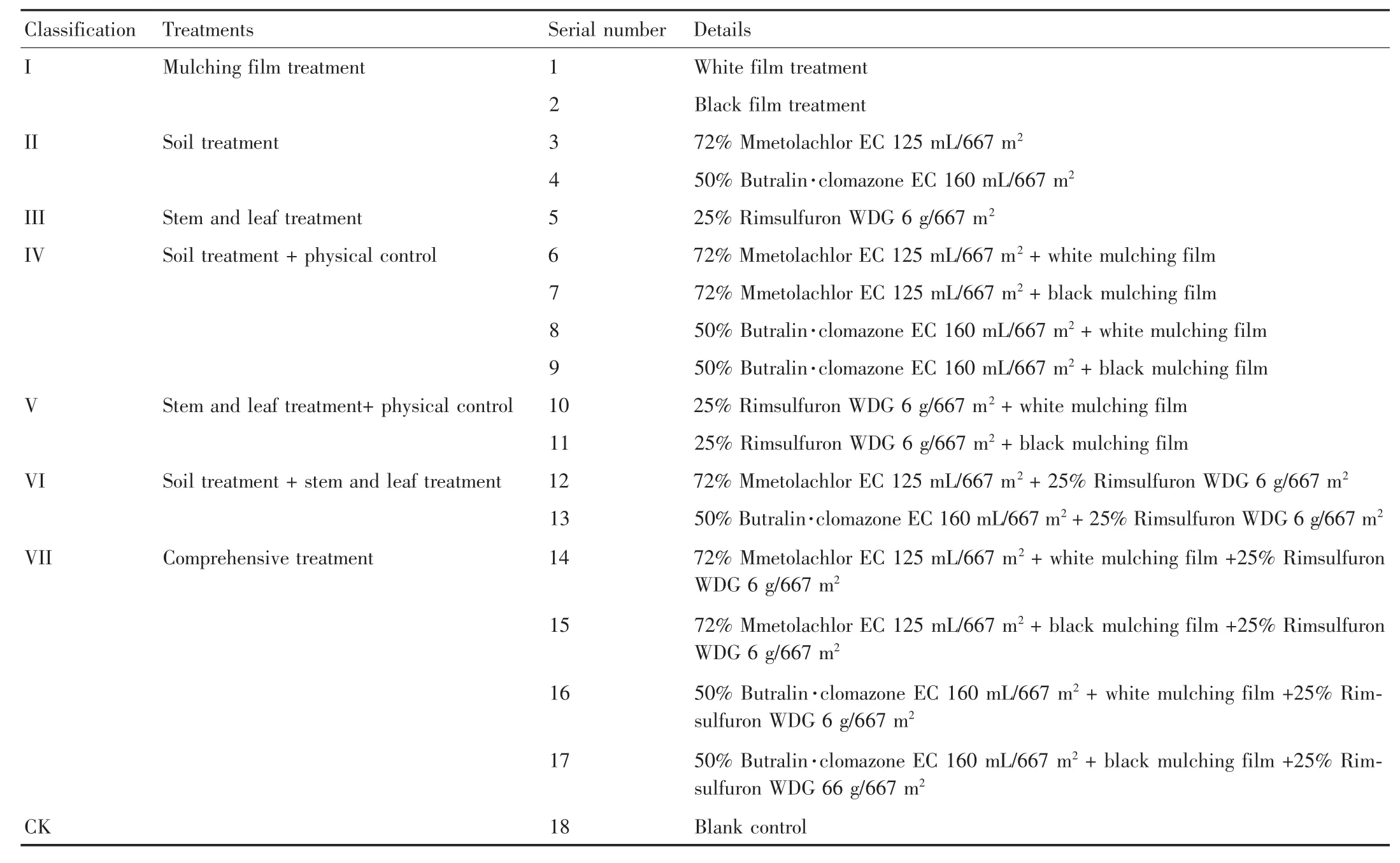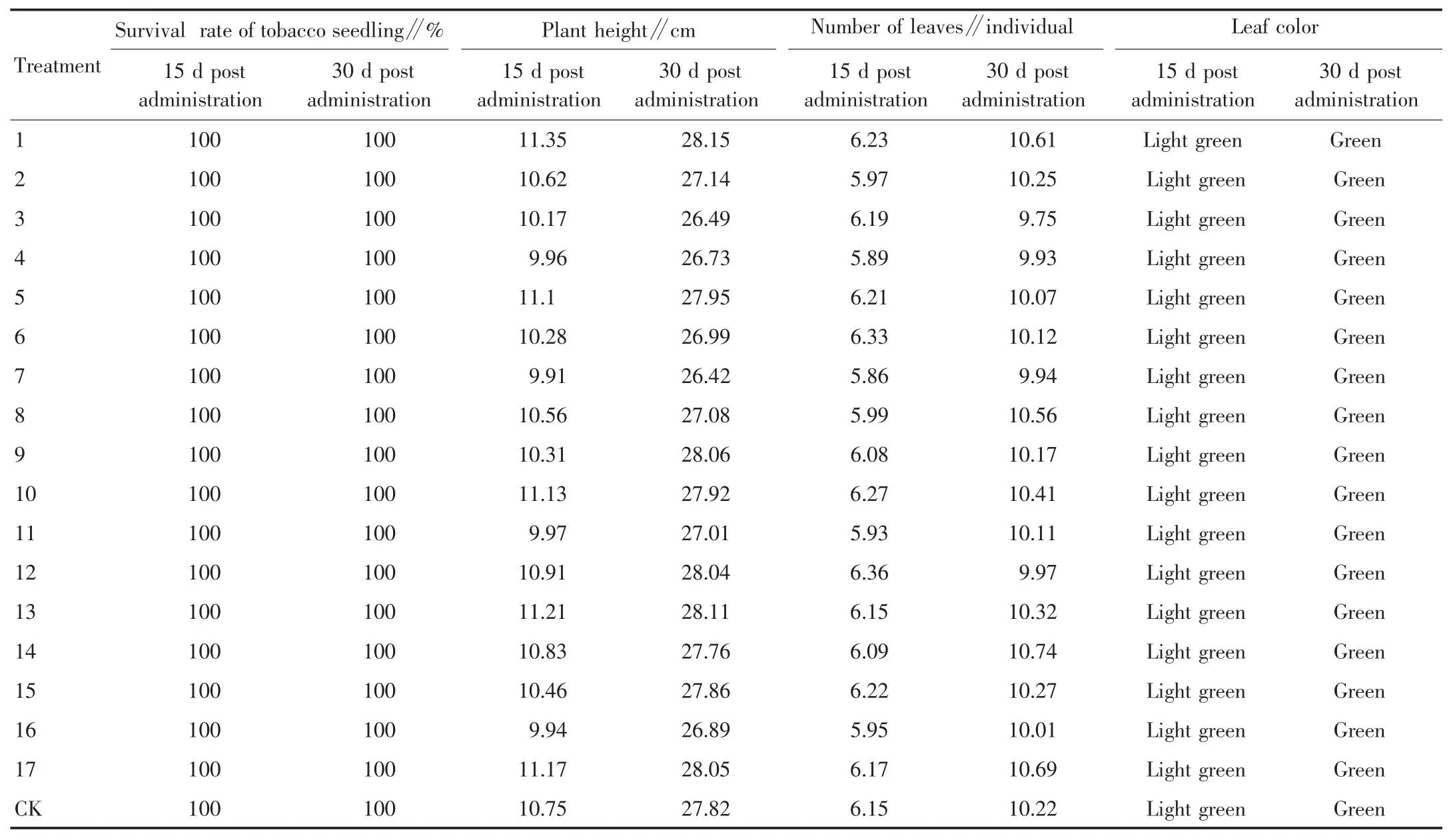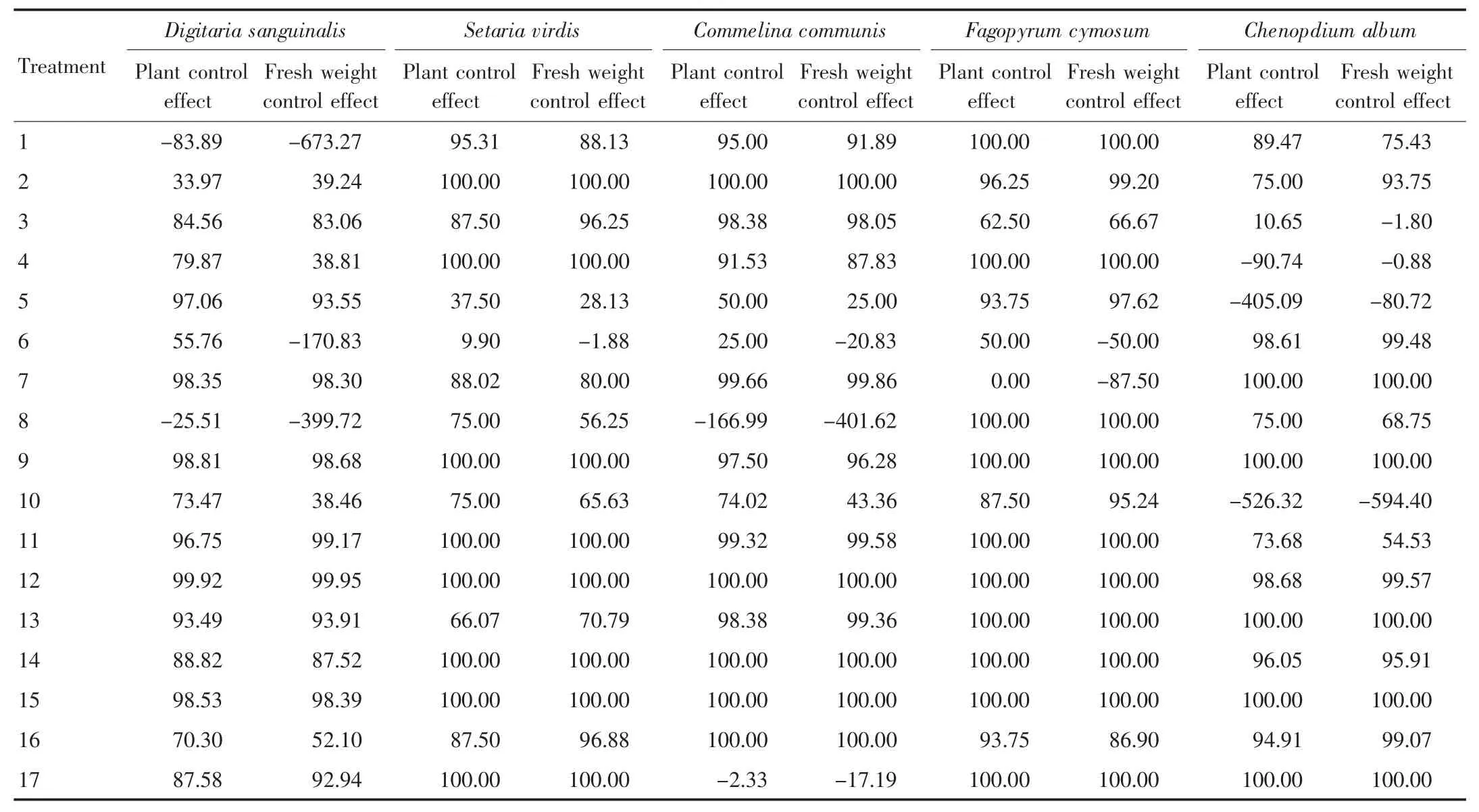Impacts of Different Weeding Methods on Weeds Control in Tobacco Fields in Anshun City
Fei Dai,Hongbo Wan,Huijuan Dai,Xiquan Li,Yuan Xue,Quan Zhang
1.Anshun Branch of Guizhou Provincial Tobacco Company,Anshun 561000,China;2.China Tobacco Hebei Industry Co.,Ltd.,Shijiazhuang 050000,China
Abstract [Objective]The paper was to explore weed control measures in tobacco fields in Anshun City.[Method]Different treatments on weed control were conducted in tobacco fields in Anshun City,Guizhou Province,from 2017 to 2019.[Result]Various treatments had no negative effect on tobacco plant growth in the field,and had different degrees of control effects on five dominant weeds,including Digitaria sanguinalis,Setaria viridis,Fagopyrum dibotrys,Commelina communis and Chenopodium album.White mulching film and 50% butralin·clomazone EC 160 mL/667 m2+white mulching film had the worst performance,which had extremely significant or significant differences with other treatments.There was no significant difference among most treatments,and the overall effects were comprehensive (multi-factor)treatment>double factor treatment>single factor treatment.[Conclusion]Combination control is recommended in practical tobacco production.
Keywords Tobacco field;Weed;Control effect;Impact
In the best season of tobacco growth,high temperature and high rainfall will lead to rapid growth of weeds,and weeds will compete with flue-cured tobacco fields for water,nutrients,light and space,which can reduce the yield of tobacco leaves by 30%-60%,or even cause total crop failure.Meantime,some weeds in the field are also the intermediate hosts of tobacco diseases and insect pests,which bring different degrees of virus infection or transmission of diseases and insects to tobacco plants,and cause infection or cessation of growth of tobacco plants,leading to serious economic losses and increasing management labor and production costs[1-5].In recent years,weed has become a prominent problem in tobacco production in Anshun,which leads to the decline of tobacco yield and quality and the decrease of farmers’income.Currently,many efforts have been dedicated to weeds in tobacco production,but there are few researches on weed control in tobacco fields[6].Although there are some reports,the effects of various solutions are different,and grass-roots staff do not know how to correctly solve the problem.In order to effectively prevent and control the harm of weeds in tobacco fields and reduce the labor cost and losses,physical control and combination of physical control and chemical weeding were adopted to explore the ways to solve overgrown weeds in tobacco leaf production.The results would provide reference for weed control in tobacco fields.
1 Materials and Methods
1.1 Chemical agents The agents used for soil treatment were 72% metolachlor EC(Guizhou Zunyi Quantong Chemical Co.,Ltd.),and 50% butralin·clomazone EC (Dagong Agrochemical Co., Ltd.,Zhangye City,Gansu Province).The agent used for stem and leaf treatment was 25% rimsulfuron WDG(DuPont,USA).
1.2 Materials for physical control White and black mulching film were used respectively.AGROLEX SCRAYER JACTO HD210 knapsack sprayer(manufactured by Agrolex Private Limited,Singapore),with the pressure of 1-2 kgf/cm2and the flow rate of 255-950 mL/min,was used for chemical spraying.
1.3 Experimental conditions The crop tested was flue-cured tobacco Nanjiang No.3.The test was conducted in Changbian Village,Machang Town,Pingba County,Anshun City,Guizhou Province.The experimental field was yellow loam with medium fertility and good irrigation conditions.The land was prepared on April 15 and planted on April 25 every year.The tobacco plants were planted at a density of 110 cm×55 cm,one plant each hole.Flue-cured tobacco special compound fertilizer(NO ∶P2O5∶K2O=10 ∶10 ∶23)was applied at the dose of 50 kg/667 m2as the basal fertilizer before planting and organic fertilizer was applied at the dose of 80 kg/667 m2.The test ground was winter idle land.
1.4 Experimental treatments The treatments designed in the test are shown in Table 1.

Table 1 Design of experimental treatments in the field
1.5 Experimental methods
1.5.1 Plot design.Physical control was conducted after ridging and fertilization,and white and black mulching films were covered,respectively.Soil treatment was conducted after ridging and fertilization,and agents were administrated at the dose of 50 kg/667 m2before transplanting.Soil treatment+physical control:white and black mulching films were covered after pesticide application.Stem and leaf treatment was conducted at 2-4 leaf stage of weeds,and agents were administrated at the dose of 30 kg/667 m2.Stem and leaf treatment+physical control:as white and black mulching films were covered,agents were administrated at 2-4 leaf stage of weeds.Comprehensive treatment:mulching film was covered after agents were administrated,and stem and leaf treating agents were administrated at 2-4 leaf stage of weeds.Blank control was also set.A total of 18 treatments were designed in the test,four repeats each treatment,with a total of 72 plots.Each plot covered an area of 15 m2.All plots were in complete randomized block design.
1.5.2 Administration methods.In soil treatments,1 124 mL of liquids were administrated in each plot,and in stem and leaf treatment 675 mL of liquids were administrated in each plot.In soil treatment,agents were administrated on April 12,a cloudy day with the temperature of 13-19℃.Agents were administrated once in the field.In stem and leaf treatment,agents were administrated on April 30,a cloudy day with the temperature of 16-26℃.Agents were administrated once at 2-4 leaf stage.
1.6 Survey methods,time and frequency The control effect was investigated at 40 d post last administration.Samples were collected at five random points from each plot,and an area of 0.25 m2was investigated at each point.The species and number of weeds were investigated respectively,and the fresh weight of aerial part of weeds was weighed.On June 21,2014,the number of remaining weeds in each plot was investigated,and the fresh weight of weeds was weighed at 40 d post last administration.
Plant control effect(%)=(Number of weeds in blank control area-Number of weeds in treatment area)/Number of weeds in blank control area×100%
Fresh weight control effect(%)=(Fresh weight of weeds in blank control area-Fresh weight of weeds in treatment area)/Fresh weight of weeds in blank control area×100%
The growth of flue-cured tobacco was observed in the field by visual survey after administration.In soil treatments,the color change and plant growth of fluecured tobacco in the plots were observed at 15 and 30 d post administration,respectively.In stem and leaf treatments,the color change and plant growth of fluecured tobacco in the plots at 15 and 30 d post administration,respectively.
1.7 Investigation of weed species in experimental plots The species and density of weeds was investigated in the experimental field,and the weeds included Digitaria sanguinalis(L.)Scop.,Digitaria sanguinalis(L.)Scop.,Paspalum distichum L.,Cynodon dactylon(L.)Pers.,Cyperus rotundus L.,Artemisia lavandulaefolia DC.,Commelina communis L.,Fagopyrum cymosum(Trev.)Meisn.,Kalimeris indica(L.)Sch.-Bip.,Chenopdium album L.,Calystegia hederacea Wall.,Galinsoga parviflora Cav.,Polygonum lapathifolium L.,Stellaria media(L.)Cyr.,Polygonum nepalense Meisn.,Hydrocotyle sibthorpioides Lam.var.and Acalypha australis L.In terms of occurrence density of weeds in the field,D.sanguinalis,S.virdis,F.cymosum,C.communis and C.album were the dominant species.
2 Results and Analysis
2.1 Impacts of different treatments on the growth of flue-cured tobacco The growth of flue-cured tobacco plants was investigated at 15 and 30 d post administration,respectively (Table 2).There was no significant difference in survival rate,plant height,number of leaves or leaf color between treatment area and control area,indicating that different agents had no negative effects on the growth of tobacco plants.

Table 2 Impacts of different treatments on the growth of flue-cured tobacco
2.2 Impacts of different treatments on weed control of dominant population in tobacco fields Through the survey of weed species and density,it was found that D.sanguinalis,S.virdis,F.cymosum,C.communis and C.album were the dominant species.Therefore,the test was conducted aiming at five kinds of dominant weeds,and the results are shown in Table 3.In physical treatments I(treatments 1 and 2),the plant control effect and fresh weight control effect on S.virdis,F.cymosum,C.communis and C.album were good,but those on D.sanguinalis were poor.In soil treatments II(treatment 3 and 4),the plant control effect and fresh weight control effect on D.sanguinalis,S.virdis,F.cymosum and C.communis were good,but those on C.album was poor.In stem and leaf treatment III(treatment 5),the plant control effect and fresh weight control effect on D.sanguinalis and F.cymosum were the best,followed by C.communis,and those on S.virdis and C.album were the worst.In the soil treatment+physical control treatments IV(treatments 6,7,8,9),the control effects on weeds successively were treatment 9>treatment 7>treatment 8>treatment 6,among which the control effects of treatment 9 on all weeds reached more than 96.28%.The control effects of treatment 7 on other weeds were above 80% except for F.cymosum.Treatment 8 showed the best control effect on C.communis and C.album,followed by S.virdis,and had the worst control effect on C.communis and C.album.Treatment 6 performed the best plant control effect and fresh weight control effect on C.album,and had certain plant control effect but no fresh weight control effect on other weeds.In stem and leaf treatment+physical control treatments V(treatments 10 and 11),the plant control effect and fresh weight control effect of treatments 10 and 11 on other weeds were good except for that of treatment 10 on C.album.In soil treatment+stem and leaf treatments VI(treatments 12 and 13),the control effects of treatments 12 and 13 on other weeds were above 93.91% except for the control effect of treatment 13 on S.virdis,which was slightly lower.In comprehensive treatments VII(treatments 14,15,16 and 17),the plant control effect and fresh weight control effect of other treatments on all weeds were good except for that of treatment 17,which had poor plant control effect and fresh weight control effect on C.communis.In conclusion,each treatment had varying degrees of control effects on the five dominant weeds,and the overall trend was comprehensive(multi-factor)treatment>double factor treatment>single factor treatment.However,multi-factor comprehensive prevention and control is relatively complicated in the actual agricultural operation,and it is not easy for farmers to take control of the process.Therefore,it is better to adopt simple combination method.

Table 3 Effects of different treatments on weed control of dominant population in tobacco fields%
2.3 Comparative analysis of control effects of different treatment methods on different types of weeds in tobacco fields Through the analysis of control effects of different weeding methods on different types of weeds in tobacco fields(Table 4),different treatments had varying degrees of control effects on gramineous weeds.For plant control effect,treatment 1 and 8 had the worst control effect,which had extremely significant difference with other treatments,and there were significant differences among other treatments.For fresh weight control effect,treatment 1 and 8 had the worst control effect,which had significant difference with treatments 3,5,7,12,13,15 and 17,and extremely significant difference with remaining treatments.Similarly,different treatments had varying degrees of control effects on broadleaf weeds.For plant control effect,although there were differences among treatments,the difference did not reach significant level.For fresh weight control effect,treatment 13 had significant difference with other treatment,while there were extremely significant difference among other treatments,and treatment 8 had the worst performance.The control effect on weed population also varied among treatments.For plant control effect,treatment 1 and 8 had extremely significant difference with other treatments,while treatments 2,6 and 10 had significant difference with the remaining treatments,and there was no significant difference among the remaining treatments.For fresh weight control effect,treatments 1,6,8 and 10 had the worst control effect,which had extremely significant difference with other treatments,while there was no significant difference among other treatments.To sum up,treatment 1 and 8 had the worst performance,while treatment 13 and 15 had the best control effect.

Table 4 Comparative analysis of control effects of different treatment methods on different types of weeds in tobacco fields
3 Conclusions and Discussion
In the experiment,soil treatment+stem and leaf treatment,soil treatment+stem and leaf treatment+black mulching film treatment had the best control effect on weeds in tobacco fields. White mulching film,white mulching film+soil treatment,white mulching film+stem and leaf treatment had the worst control effect on weeds in tobacco fields.In practical production,it is recommended to use soil treatment+stem and leaf treatment with relatively simple agricultural operation and relatively low cost for weed control in tobacco fields.If mulching film is needed,it is suggested to use black mulching film or soil treatment+black mulching film for weed control in tobacco fields[7-9].
Each single factor treatment had certain control effect on weeds in tobacco fields,but their control effects were lower than those of combination treatments.The overall control effect of white mulching film was poor.Whether white mulching film has certain influence on drug efficacy or technical operations are not in place still needs to be further studied.In addition,due to more experimental treatments and larger distribution of experimental fields,uneven distribution of weeds in the field may have certain influence on the control effect of single weed species in the tobacco fields[10-16].
- 植物病虫害研究(英文版)的其它文章
- Effects of Common Mineral Trace Elements on Immune Function of Livestock and Poultry
- Comparison of the Effects of Pesticide Application on Biston suppressaria Larvae in Different Damage Stages
- Spectral and Photosynthetic Characteristics of Cotton under Chemical-controlled Topping Technology
- Synergistic Effect of Adjuvant Green Orange Peel Oil on Different Herbicides
- Effects of Guangxi Hepu Pearl Hydrolysate on Proliferation Activity and Apoptosis of Human Hepatic Stellate Cells
- Development of"Multi-Resistance Rice"by Pyramiding of Insect(Cry1C)and Blast Resistance(Pi1 and Pi2)Genes

